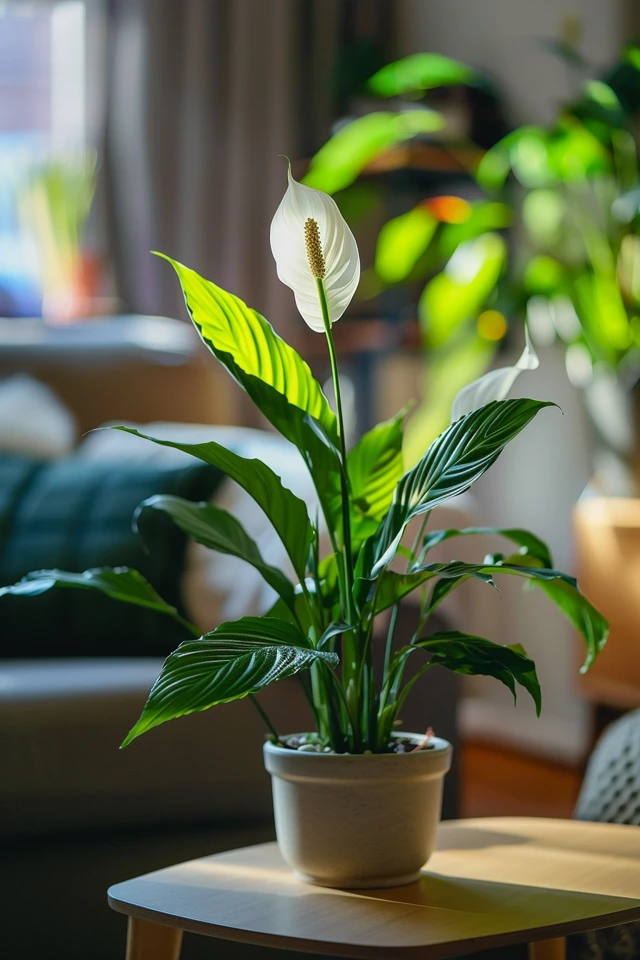Hi there, fellow green thumbs! Are you struggling to get your Peace Lily to bloom? Don’t worry, I’ve got you covered. In this article, I’ll share some valuable care tips and tricks to help you promote the beautiful flowering of your Peace Lily.
Peace Lilies are known for their striking white flowers and lush green leaves, making them a popular choice among indoor plant enthusiasts. However, getting these delicate beauties to flower requires some specific attention to their needs.
So, how can you encourage your Peace Lily to bloom? Let’s dive in and discover the secrets to promoting those stunning flowers.
Key Takeaways:
- Provide brighter, indirect light to encourage blooming.
- Maintain a temperature range of 75 to 85 °F.
- Ensure your Peace Lily is mature enough to flower.
- Use a flower or bloom fertiliser for added nutrients.
- Feed your Peace Lily regularly with a low-salt fertiliser.

Lack of Sufficient Light
Peace Lilies are beautiful houseplants that add a touch of elegance to any space. However, ensuring they receive the right amount of light is crucial for their overall health and blooming potential. While these plants can tolerate low-light conditions, insufficient light can prevent them from flowering.
Peace Lilies prefer medium to bright indirect light. Placing them near a north or east-facing window is ideal as it provides the perfect balance of brightness without exposing them to direct sunlight. Direct sunlight can easily scorch the thin leaves of Peace Lilies, leading to unsightly damage.
Did You Know? Green flowers instead of white can be a sign of too much light exposure. If your Peace Lily’s flowers are looking more green than white, it’s a good indication that it’s receiving excessive light.
If your Peace Lily is not flowering or if the leaves appear weak and pale, it may be a sign of insufficient light. To encourage blooms, it is recommended to shift the plant to a new position with brighter, indirect light. You can also consider using artificial light sources, such as grow lights, to supplement the natural light if necessary.
Remember, each plant is unique, and its light requirements may vary slightly. It’s important to observe your Peace Lily’s response to light and make adjustments accordingly. By providing the right amount of light, you can ensure that your Peace Lily thrives and blooms beautifully.

Final Thoughts
Proper light exposure is vital for the overall well-being of your Peace Lily. Insufficient light can hinder its blooming potential, while excessive light can lead to leaf scorching. By understanding the light requirements of your Peace Lily and making the necessary adjustments, you can create the perfect environment for it to thrive and showcase its beautiful flowers.
The Wrong Time of Year
Although Peace Lilies can technically flower at any time of year with the right conditions, they naturally bloom in spring or early summer. If a Peace Lily is not flowering, it may simply be the wrong time of year. However, with the right care, these plants can continue to bloom throughout the year. Providing ideal conditions and fertilizing appropriately can encourage blooms even outside the natural flowering season.
Peace lilies have a preferred flowering season in the spring and early summer, but they can still bloom at other times. By providing the right care and optimizing their environment, you can encourage peace lilies to flower year-round.
Optimizing the Environment
- Place your peace lily in a location with bright, indirect sunlight. Avoid direct sunlight, which can damage the leaves.
- Maintain a consistent temperature range of mid to high 20s (75 to 85 °F). Avoid exposing your plant to temperatures below 18 degrees, as this can hinder flowering.
- Keep the soil consistently moist but not waterlogged. Overwatering can lead to root rot, while underwatering can cause stress and prevent blooming.
- Ensure proper drainage by using a well-draining potting mix and a pot with drainage holes.
Fertilizing Appropriately
“Feeding ‘little and often’ with a low-salt fertiliser is recommended.”
– Expert Gardener
Fertilizing plays a vital role in encouraging peace lilies to bloom. Use a balanced, low-salt fertilizer specifically formulated for flowering plants or a bloom fertilizer to provide the necessary nutrients. It’s important to follow the package instructions and feed the plant in moderation to avoid overfertilization.
By creating the right conditions and providing proper care, you can help your peace lily bloom and thrive, even if it’s not the typical flowering season. Enjoy the beauty of its elegant white flowers throughout the year.

Immaturity and Other Factors
If your Peace Lily isn’t flowering, it could simply be because the plant is not mature enough. Peace Lilies typically take 1 to 3 years to reach maturity and start blooming, even if they were flowering when you first brought them home. Some commercial growers use controlled conditions and growth hormones to induce blooms, so a young Peace Lily may need more time to develop and bloom naturally.
Another factor that can prevent Peace Lilies from flowering is low temperatures. These tropical plants thrive in temperatures between 20 and 30 degrees Celsius (68 to 86 degrees Fahrenheit). If the temperature drops below 18 degrees Celsius (64 degrees Fahrenheit), it can hinder the plant’s ability to produce flowers. So make sure to keep your Peace Lily in a warm spot to encourage blooming.
Feeding your Peace Lily with the right nutrients is also crucial for promoting abundant flowers. While Peace Lilies are not heavy feeders, they still require proper nutrition to thrive. To encourage blooms, use a flower or bloom fertilizer and feed your plant regularly with a low-salt fertilizer. This will provide the necessary nutrients for your Peace Lily to produce beautiful, vibrant flowers.

